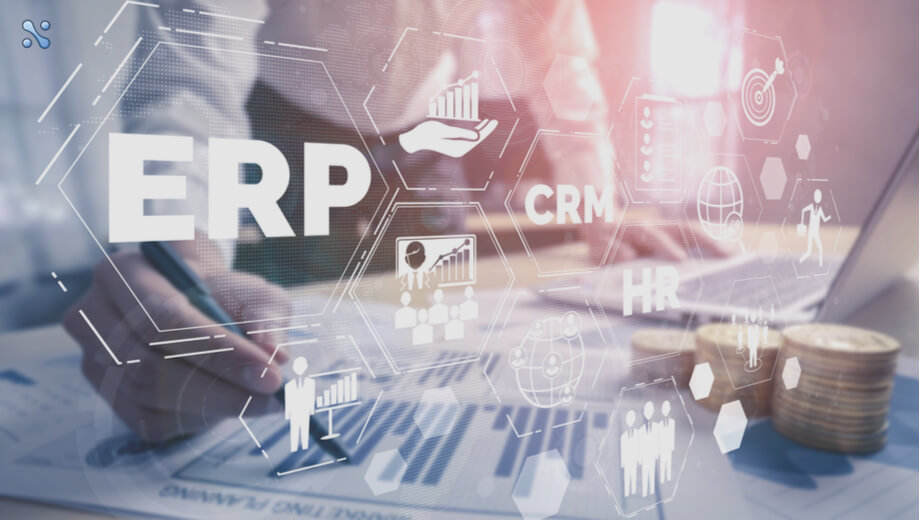Enterprise Resource Planning, or ERP, solutions transform businesses by streamlining critical business processes. Although, businesses strive to implement ERP systems and gain a thorough understanding of how they work.
According to Manufacturing Business Technology, “accurate planning and evaluation are critical because 74% of ERP projects experienced cost overruns in 2016.”
Thus, this ratio demonstrates unequivocally that the majority of businesses do not understand how ERP is implemented.
What is Enterprise Resource Planning (ERP) Implementation?
-
- Examines current business practises
- Performs calculated planning
- Restructures operating processes
- Installs software
- Performs installation testing
- Manages change
- Performs support maintenance
- Performs user testing, among other business processes.
ERP implementation, on the other hand, is not a onetime event; it is a continuous process in which businesses must invest time.
The Steps to a Successful ERP Implementation
Thus, what are the steps involved in implementing an ERP system successfully? Given businesses’ continued scepticism regarding ERP implementation, it is critical to understand the steps that result in the desired outcomes.
Research
To be sure, ERP implementation, like any other business process, begins with research. What is the rationale for implementing ERP? Have you defined the scope and vision for your ERP implementation? And, whether ERP implementation will provide you with any benefits? In short, many questions must be answered to ensure that the ERP implementation is accurate.
Additionally, an ERP implementation team must be formed with the intent of communicating effectively, imparting accurate knowledge, and committing to training all project participants from start to finish.
What is the Purpose of ERP Implementation?
To begin, current business processes should be documented and analysed. Following that, examine how these processes are flowing from one department to the next. While analysing these processes, you will also identify many potential shortages, errors, or problems that may cause problems for the teams, besides identifying missed customer opportunities.
The primary requirement is to understand existing business processes, which will help define the ERP implementation’s objectives and goals. The success of an ERP implementation is also contingent upon how specific you are in your goal setting. Which performance indicators are used? What are the desired outcomes? You must be precise in defining the ERP implementation requirements.
Your research phase should also include establishing a reasonable budget and timeline. Avoid false hopes for ERP implementation.
Pro Tip: Select employees who will have a significant impact on the ERP software implementation. You will need to invest some time and effort to ascertain the identity of such employees, but this is not impossible. After determining which employees are significantly affected by this system, it is necessary to brainstorm, keeping them in mind before making a final decision.
The Following Comes with the Installation
After conducting extensive research, the next step is proper installation. Why is ERP implementation given such top priority in modern businesses? To put it simply, it enables you to estimate current business operations rather than repeatedly restructuring them according to standard processes.
You will also need to monitor automating business processes throughout this process. A blueprint must be structured in such a way that it conveys knowledge about how new business practices will flow or operate within the system.
Generally, the application development company will be responsible for ERP implementation and infrastructure development. It also encompasses additional processes, such as data collection and networking capabilities.
Thus, the next step would be to install the ERP software and allow it to run throughout the organization’s various departments.
Expansion
The third stage of ERP implementation is data migration. It entails transferring all records and data to the new system. Almost every business accumulates information about its suppliers, customers, and assets. The records are typically stored in a variety of formats and databases, which increases the likelihood of incorporating undesirable information and errors. To ensure uniformity and precision, data should be analysed and edited. Prior to initiating the migration process, the ERP implementation should be decommissioned.
After removing, updating, and verifying the data, the migrant migrates it to the new system. This step also includes mapping database fields, creating new databases, and transferring data.
Testing the Implementation of the ERP
Test engineers are accountable for ensuring the quality of implemented ERP systems. They test the systems’ user interfaces, functionality, and details. The same must be verified, regardless of whether it is applicable in real life.
It will be implemented further only if it is applicable in real life. Otherwise, the process will be re-examined to ensure that it is worthwhile for users. Additionally, the test engineers will validate the processes that flow between departments. The only requirement prior to going live with this system is a thorough test to ensure that there is no room for error in the ERP system.
Training Times
The following step is to provide training on how to operate the ERP software precisely. It will take sufficient time and effort to educate employees about this software. Given that some staff members will work on ERP almost daily in the future, they must gain a complete understanding of the business process.
How long it will take to complete the training depends on a range of factors, including the ERP’s size, complexity, and features. Additionally, users must adapt to the ERP software, which takes time. As a result, sufficient time should be allowed for users to become acquainted with the ERP software.
Software Deployment
The size of an ERP project dictates the method by which the software will be implemented in a particular business. The first method is referred to as ‘phased,’ in which users switch between business functions. While the process is lengthy, the team can improve transitions. However, integrating ERP modules one by one can be a lengthy process. Another option is parallel operation, which utilises both systems concurrently.
The primary reason that both systems are used is to provide organisations with a backup. Because this is the least risky method, most organisations rely heavily on it. However, it can be quite costly. The final method is the big bang, in which all users are switched over to the new system in a single day. While this method is expedient, it may cause operational difficulties.
Develop a communication strategy prior to ERP implementation to make the process easier and faster for your business. Assure that both users and employees receive adequate training to ensure the ERP implementation is a success.
Constant Assistance
The go-live date does not mark the conclusion of the ERP implementation process. Ongoing support and maintenance are required to ensure that the end-user experience is as simple as possible. Additionally, budget and time are required to provide continuous support to end-users. The primary goal is to provide continuous support to users, even after the ERP implementation is complete.
Thus, users need not be concerned about using the ERP, as it is constantly supported by those who implemented and tested it.
Thus, these were some steps toward implementing an effective ERP system. Using this guide can assist you in properly implementing the ERP. However, some business newcomers or even ERP novices may make some errors. That is entirely natural; however, anticipating a few of these errors can save you.
Making Errors While Developing Your Company’s ERP
ERP is the ideal solution for modern business owners. ERP software manages sales, human resources, finance, and virtually every other department. It saves a lot of money and time because ERP centralises all information. However, avoid these errors to ensure that your efforts are successful.
The Message to Remember
A successful ERP implementation can have a significant impact on your business. You can use your company to speak for itself and establish a presence in a competitive market. So, are you interested in implementing ERP and gaining a competitive edge? Want to take your business to the next level by incorporating ERP solutions? Therefore, look no further than Neuronimbus Solutions. We try to comprehend and accomplish your objectives. Kindly contact our IT outsourcing services and we will respond as soon as possible.
Reference: [1]
FAQs About Benefits of Enterprise Resource Planning
Q. What are the primary benefits of Enterprise Resource Planning (ERP)?
A. ERP systems streamline business processes, enhance data accuracy, improve productivity, and provide real-time information for better decision-making.
Q. How does ERP improve decision-making in businesses?
A. ERP provides integrated, real-time data across departments, enabling informed decision-making by offering a comprehensive view of business operations.
Q. Can ERP systems reduce operational costs?
A. Yes, ERP systems can significantly reduce operational costs by automating routine tasks, minimizing errors, and improving process efficiency.
Q. How does ERP benefit inventory management?
A. ERP aids in efficient inventory management by tracking stock levels, optimizing order quantities, and reducing excess inventory, leading to cost savings.
Q. Can ERP systems enhance customer service?
A. ERP systems enhance customer service by providing quick access to customer information, improving response times, and ensuring accurate order processing and delivery.
Q. What is the impact of ERP on supply chain management?
A. ERP positively impacts supply chain management by improving visibility, streamlining procurement processes, and enabling better coordination among suppliers.
Q. How do ERP systems assist in financial reporting and compliance?
A. ERP systems assist in financial reporting and compliance by automating financial operations, ensuring accuracy, and providing timely, regulatory-compliant reports.
Q. Can ERP integration lead to improved employee productivity?
A. Yes, integrating ERP systems can lead to improved employee productivity by reducing manual tasks, facilitating access to information, and enabling efficient workflow management.
Q. How does ERP support business growth and scalability?
A. ERP supports business growth and scalability by providing flexible and scalable solutions that adapt to changing business needs and expansion requirements.
Q. What are the long-term benefits of implementing an ERP system?
A. Long-term benefits of ERP include sustained operational efficiency, continuous process improvement, strategic planning support, and enduring competitive advantage.





